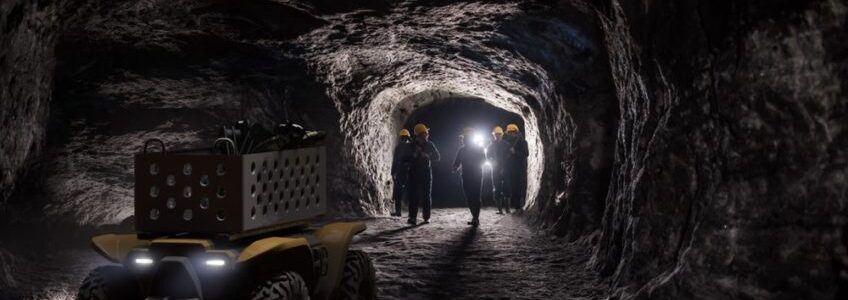Robotics and automation have made headlines in recent years, especially in the construction sector with some tremendous advancements. While robotics in construction may be deemed a game-changer, the technology has not yet exceeded expectations but it is promising nonetheless. Without creating too much hype, here’s a measured look at the capabilities and benefits of robotics in construction.
The robotics industry has advanced tremendously in recent years with several cutting edge developments. Now, researchers have created a hydrogel-based, light-powered robot that swims in response to a direct light source.
This particular robot, the OsciBot, is attracted to and only powered by a constant visible light source. It doesn’t require a battery pack or power tether of any kind. This type of technology could revolutionise the maritime industry in terms of energy harvesting and propulsion in the future.
Robotics of all types and sizes with various applications have made headlines around the world adding fuel to the innovation fire. The oil and gas industry has always been a leader in pushing the boundaries of disruptive technologies. Now, with rising interest and investment, subsea robotics has the potential and power to transform the oil and gas sector as a whole.
Technological advancements and the continued race for innovation in nearly every industry is evident across the globe. For some time now, oil companies have turned to robots and drones to perform dangerous activities in the harshest environments. While some of the ‘oil and gas tech toys’ help save costs, many of them greatly improve performance and safety. This is as a result of fewer people being exposed to dangerous tasks and situations.
Image Credit: Boeing
Back in 2017 we reported on the Boeing Echo Voyager autonomous unmanned submarines and now, big brother is here. It comes in the form of the Orca Extra Large Unmanned Undersea Vehicles (XLUUVs) built for a host of applications.
The US Navy awarded Boeing with a US$43 million contract to build four Orca’s and the support gear. Boeing partnered with Huntington Ingalls Industries to develop the 51-ft (15.5 m) long unmanned undersea vehicles which will operate in the open ocean. This is largely thanks to next-level autonomous navigation systems and a fuel module that gives the Orca an incredible range of 6,500 nm (7,480 mi / 12,038 km).
But to get a real idea of the engineering ingenuity of the Orca, let’s recap on the Boeing Echo Voyager.
Image Credit: Honda
Honda is making headlines once again as they seeking potential business and technology partners for their prototype off-road vehicle. Honda’s Autonomous Work Vehicle combines the automaker’s all-terrain vehicle (ATV) and advanced autonomous technology. Honda R&D Americas have designed the Autonomous Work Vehicles to improve efficiency and safety.
They aim to target public, commercial and consumer enterprises with the potential to support a host of industries. Some of these include search and rescue, firefighting, construction, agriculture, landscaping and snow removal. Honda will feature their Autonomous Work Vehicle at CES 2019 in Las Vegas Convention Center from January 8-11, 2019.
3D printing, often referred to as Additive Manufacturing (AM) is the sequential layering of materials using computers to create three-dimensional shapes. The process appears relatively simple as a 3D digital model of the item is created. This is done either through computer aided design (CAD) or using a 3D scanner.
The printer reads the design and “prints” successive layers of a medium, either liquid, powder, or sheet material. These are joined together or fused to create the final product or item. While the 3d printing process can sometimes be slow, it can create almost any shape which is particularly useful for geometrically complex components.
The future of construction lies with robots getting down and dirty while implementing 3D printing technology. And now, 3D printing has found yet another purpose with the US military building barracks using a large 3D printer.
Much has been said about the promising future of UK manufacturing and engineering but what does the future hold? Everyone knows that Britain is the birthplace of the industrial revolution and remains a global leader in manufacturing. This applies especially to the aerospace sector as it’s the largest in Europe and only second to the US. In 2016, there were more than 2.6 million people directly employed in manufacturing in the UK alone.
The south-west of England is the largest aerospace region in Europe and home to 15 large aerospace companies. In addition, the cluster also consists of a large network of world-class supply chain companies.
Manufacturers have started to make the transition to new processes striving for greater productivity and functionality. Technological advancements in the last few years mean
We see the benefits of 3D printing all the time from manufacturing, medical, the fashion industry to prototyping and production. With construction in mind and large-scale 3d printers, it is now possible to think about bigger projects. There’s no doubt that that additive manufacturing is an ideal building solution for creating models in architecture.
With that in mind, 3D printing has made headlines once again. This time though, it’s not a 3D printed house in your neighbourhood unless you live on Mars. We take a closer look at how the 3D printed habitat challenge from NASA and their partners have developed. If you are remotely interested in aerospace design, engineering and space exploration, you should really watch these videos.











Recent Comments